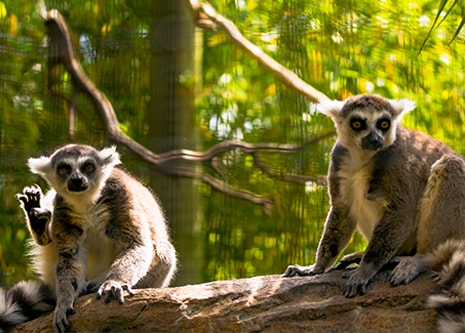
- VisitSupport Happy HollowDONATE TODAYExploreSupport Happy HollowDONATE TODAYLearnSupport Happy HollowDONATE TODAYSupportToday’s Hours: CLOSEDZoo in the Hollow
Ring-tailed lemurs

Scientific name: Lemur catta
Family: Lemuridae
Order: Primates
Class: Mammalia
Range: South and Southwestern Madagascar
Habitat: Dry and tropical forests
Lifespan: 12 to 15 years in the wild; over 30 years in captivityWhat do they look like?
Ring-tailed lemurs are 15 to 18 inches long, not including the tail, and weigh only as much as a small cat, around five to eight pounds. They have grey bodies with lighter bellies. They have white fur around their ears and face, with black patches around the eyes and nose. Their trademark tail is long and bushy, striped with black and white, and can be up to 25 inches long, longer than the rest of their body.How do they behave?
Unlike most lemur species, ring-tailed lemurs are primarily terrestrial, preferring to live on or near the ground rather than in trees. Ring-tailed lemurs are diurnal (active mainly during the daytime) and spend a good portion of their day grooming themselves and each other with specialized lower incisors, known as a “toothcomb”, and “toilet-claws” found on the second toe of each hind foot. Ring-tailed lemurs are very vocal, using grunts, calls and purrs to communicate with each other. They will also use their long banded tails and potent scent glands as forms of communication. Male ring-tailed lemurs will often cover their tails with odor from the scent glands on their wrist and shoulders. After their tails are covered with scent, they will wave them at one another (a behavior known as stink fighting) to compete for breeding rights with females. Ring-tailed lemurs are social animals and form female-dominant troops of up to 30 individuals. Hierarchies exist for both the males and females of the troop, with females enforcing their own status and age dictating male dominance.What do they eat?
Ring-tailed lemurs are primarily herbivorous, with their diet consisting mostly of fruit and leaves. However, they also have been known to eat eggs, small mammals, and insects. At Happy Hollow they are fed leaf-eater chow, fruits and vegetables.How are they born?
Breeding occurs from April through May for this species. Gestation lasts approximately 135 days and nearly always results in a single birth. Mothers carry their newborns on their chest for the first week or two, then on their backs until the young lemurs are ready to explore the world on their own. Young females are permitted to stay with the troop while males are required to leave upon reaching three to five years of age.Conservation
The conservation status of ring tailed lemurs is listed as Endangered by the International Union for Conservation of Nature . One of the main threats to these lemurs is habitat loss and human predation. In 2012 the Duke Lemur Center adopted the SAVA (Sambava-AndapaVohemar-Antalaha) Conservation Madagascar initiative, a program designed to improve the conservation status of lemurs in Madagascar. SAVA Conservation Madagascar focuses on community based conservation, research, and habitat preservation. If you would like to help ring-tailed lemurs you can start by purchasing coffee that is shade-grown and produce that is grown locally. These products do not require the destruction of rainforest land to grow crops and they will help out your local economy.
Zoo on the Hill
Located across from the Keep-Around Carousel is the Zoo on the Hill. Learn about wildlife up close during daily meet-and-greets, leap like a lemur on the playground, brush and feed the goats,, or take a peek inside Doc’s Critter Care building and the Ranch House. Double-H Ranch features a combination of animal exhibits, including giant anteaters and red ruffed lemurs, as well chickens and domesticated animals that are docile enough to touch.
See Animals
Education Ambassadors
From camps and classes to scout badges and sleepovers, Happy Hollow education programs have something for everyone! The zoo education program offers a broad range of hands-on, engaging programs and public presentations featuring education ambassador animals. These encounters are designed to connect you to wildlife and the conservation of their habitats around the world.
See AnimalsVisit Us Today
Plan an unforgettable experience at San Jose’s family-friendly park and zoo.
Learn more